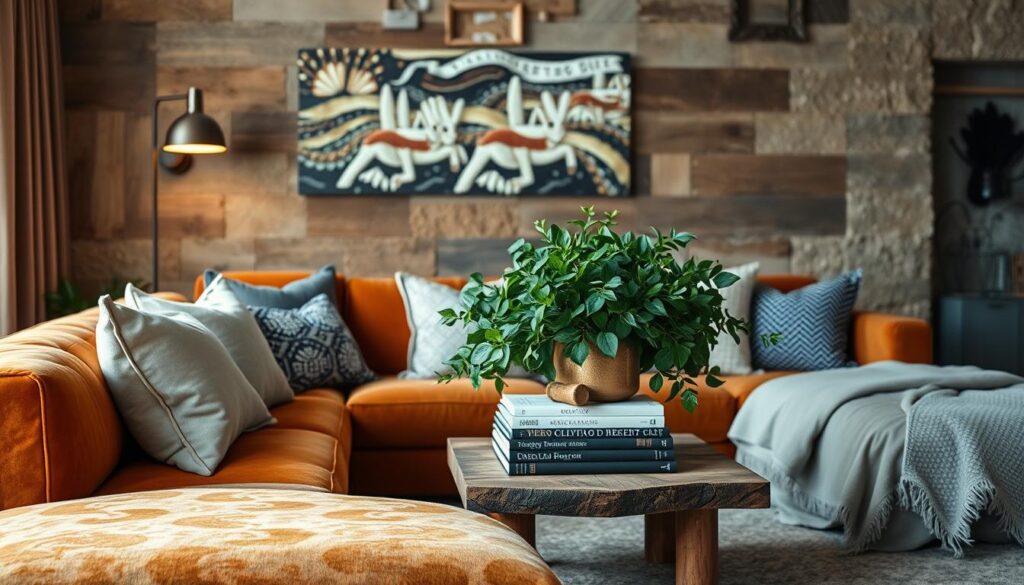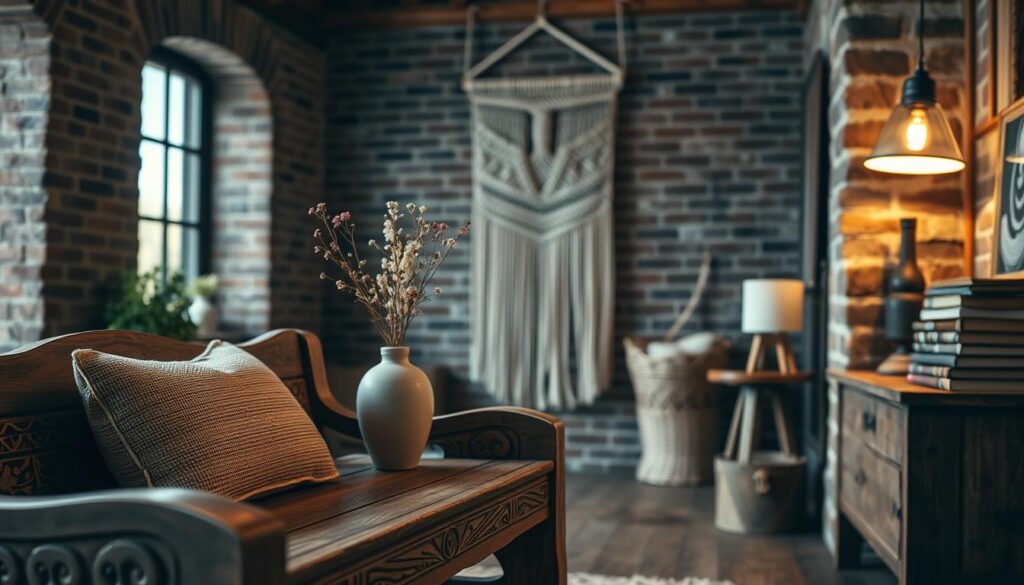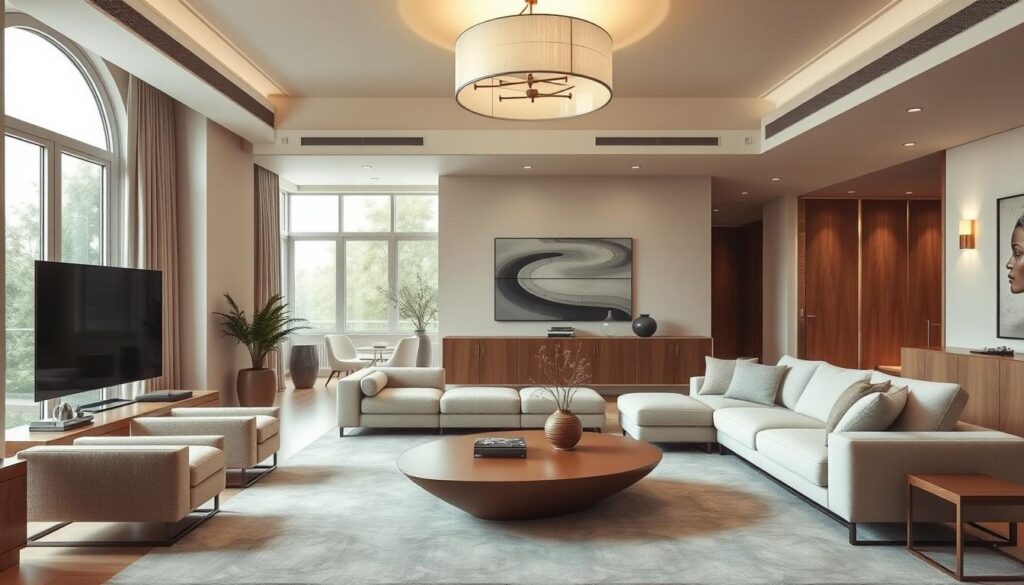As we enter 2023, the world of interior design is full of new ideas and styles. The focus on sustainable living means eco-friendly design is now a big deal.
We’re seeing a big change towards making spaces that show who we are and help us feel good. We aim to show you the best home interior trends for 2023. These trends will make your home a cozy and stylish place.
Key Takeaways
- Discover the latest eco-friendly design elements
- Explore the integration of smart technology in interior design
- Learn how to create a space that promotes well-being
- Stay ahead of the curve with the top interior design trends for 2023
- Get inspiration for transforming your living space
The Rise of Eco-Friendly Design
In recent years, the home decor industry has seen a big shift towards eco-friendly design. This change is driven by people wanting to live more sustainably. Interior designers and homeowners are now looking for ways to be kinder to the planet without losing style or function.
Eco-friendly design includes many things, like the materials used in furniture and adding natural elements to homes. Two big parts of this trend are using sustainable materials and adding biophilic elements.
Sustainable Materials
Sustainable materials are those that are good for the environment. They can be recycled, recyclable, or harvested in a way that’s kind to the planet. Some examples include:
- Reclaimed wood
- Bamboo
- Low-VOC (Volatile Organic Compound) paints
- Recycled metal and glass
| Material | Environmental Benefit | Design Application |
|---|---|---|
| Reclaimed Wood | Reduces waste and preserves history | Furniture, flooring, wall decor |
| Bamboo | Fast-growing, renewable resource | Furniture, flooring, accessories |
| Low-VOC Paints | Improves indoor air quality | Walls, ceilings, trim |
Biophilic Elements
Biophilic design brings nature into your home to make you feel better and more connected. It uses natural materials, plants, and light.
Here are some ways to add biophilic elements to your home:
- Adding plants or a living wall
- Using natural light to illuminate spaces
- Incorporating natural textures and patterns
By using sustainable materials and biophilic elements, you can make your home beautiful and eco-friendly. As we keep exploring new home decor trends, it’s clear that eco-friendly design is here to stay.
Minimalism with a Twist
Interior design has evolved, making minimalism a canvas for creativity. It’s not just about simplicity. It’s about making a space that’s both functional and beautiful, showing off our personality.
Functional Furniture Ideas
Functional furniture is key to a minimalist look with a twist. Items like storage ottomans, multifunctional sofas, and sleek coffee tables with storage keep spaces clutter-free. They also serve more than one purpose.
A storage bed can change a small bedroom, offering lots of space for linens and clothes. A nesting table adds extra surface area when needed and folds away neatly.
Clean Lines and Spaces
Clean lines and uncluttered spaces define minimalist design. To get this look, you need to choose only the most essential and beautiful items.
Using neutral colors on walls and floors brings calm and flow. Adding plants or a bold piece of art brings personality without clutter.
Color Accents
Minimalism often sticks to neutral colors, but adding color accents can be a twist. This can be done with throw pillows, rugs, or a bold wall color.
The trick is to balance bold colors with the rest of the minimalist decor. A vibrant rug can add color to a room with neutral tones, becoming a focal point.
Warm Color Palettes
In 2023, warm color palettes are back in style, making homes feel cozy and welcoming. These trends show no signs of fading away.
Warm colors turn a house into a home, making it feel snug and inviting. This trend focuses on colors that bring warmth and comfort. It’s perfect for creating a relaxing space.
Earthy Tones
Earthy tones, like terracotta, sienna, and umber, bring nature indoors. Earthy tones are great for walls and furniture, adding a natural feel.
Soft Neutrals
Soft neutrals, such as beige, caramel, and honey, create a soothing background. These colors let you add color with furniture and decor. Soft neutrals help make a space calm and peaceful.
Statement Colors
For a bold look, try vibrant colors like terracotta red, golden yellow, or burnt orange. These statement colors can be used to highlight areas or make a big impact.
When using warm color palettes, balance is key. Mix earthy tones, soft neutrals, and statement colors to create a welcoming space. This way, your home reflects your unique style.
Multifunctional Spaces
Homes are now designed with spaces that serve many purposes. This change is due to the rise of flexible work arrangements. It’s important to make these areas both functional and beautiful.
Smart furniture solutions play a big role in creating these spaces. These designs use space wisely and offer multiple uses. They are ideal for today’s homes.
Smart Furniture Solutions
Smart furniture is changing how we use our living areas. Items like sofa beds that turn into desks or desks with storage are common. They make a room more useful.
- Convertible furniture that changes function as needed
- Storage units that double as decorative elements
- Modular furniture that can be rearranged
Home Office Integration
With more people working from home, having a dedicated office space is key. This space should be both productive and cozy.
To set one up, consider these tips:
- Choose a quiet spot with few distractions
- Invest in ergonomic furniture for comfort
- Use technology like smart lights and noise-cancelling headphones to boost productivity
By using smart furniture and integrating a home office, we can make our spaces more versatile. These trends are making our homes more efficient, comfortable, and fun.
Vintage Revival
The vintage revival trend is a mix of old and new. It brings elements from the past into our homes today. This creates a rich, layered look.
This trend is more than just old furniture. It’s about choosing vintage items that tell a story. It makes your home unique and personal.
Retro Patterns
Retro patterns are key in vintage revival. Think vintage florals, geometric shapes, and abstract designs. You can use these patterns in wallpaper, upholstery, or textiles.
- Geometric patterns can add a dynamic touch to your living room.
- Floral patterns can bring a soft, romantic feel to your bedroom.
- Abstract designs can be used to create a unique statement piece.
Antique Furniture
Antique furniture is vital in vintage revival. Items like vintage armchairs and antique coffee tables add elegance. But, mix these with modern pieces to avoid a cluttered look.
Tips for mixing antique furniture with modern decor:
- Start with one or two statement antique pieces and build your modern decor around them.
- Use antique furniture to add texture and depth to your space.
- Don’t be afraid to restore or repurpose antique pieces to fit your modern lifestyle.
Incorporating Heirlooms
Adding family heirlooms to your decor connects you to your past. Heirlooms can be antique jewelry, vintage clothing, or old photos. Displaying them thoughtfully makes your home feel personal and storied.
“The way we decorate our homes is a reflection of who we are, and incorporating heirlooms is a beautiful way to tell our family’s story.”
By embracing vintage revival, you can make your home stylish and full of history. It’s a chance to blend the past with today, creating a unique interior style.
Textures and Layers
Textures and layers are key in interior design. They can turn a simple space into a lively, engaging place. By using various textures and layers, homes become more inviting and visually interesting.
Mixing different fabrics is a great way to add depth. For example, a velvet sofa with a chunky throw blanket makes a cozy spot. To keep up with trends, try out different fabric mixes.
Mixing Fabrics
When mixing fabrics, think about texture, pattern, and color. A smooth linen sofa with a chunky throw creates a nice contrast. A bold rug with a solid sofa adds depth to a room. As trends show, balance is key for a harmonious space.

Tactile Surfaces
Adding tactile surfaces makes a room more sensory. Use natural elements like wood or stone, or textures like faux fur. A wood coffee table warms a room, while a faux fur rug makes it cozy.
By mixing textures and layers, homes become more than just pretty. They become places that feel good too. As we look at new trends, textures and layers will keep making homes welcoming and stylish.
Open Concept Layouts
The trend of open concept living spaces is growing in home decor. These layouts make our homes feel bigger and easier to move around. They also help us socialize better in our homes.
Seamless Transitions
Open concept layouts offer a big advantage: seamless transitions between areas. By removing walls, we get a smooth flow between rooms. This makes our homes look better and work better too.
To get seamless transitions, use consistent flooring in the open area. This creates a look that ties everything together. Also, a unified color scheme helps keep the flow and look of the space consistent.
Inviting Atmospheres
Creating a welcoming feel is key in open concept layouts. We can use design elements like layered lighting to make the space cozy. This lighting mix adds warmth and function to the area.
Using textiles and fabrics also adds warmth and depth. Plush rugs, comfy seats, and soft furnishings make the space cozy. It’s important to balance openness with cozy elements too.
By focusing on open concept layouts, we can make our homes stylish and practical. This approach to decor improves our living experience and shows off our personal style.
Statement Lighting
Statement lighting is changing how we design our homes. It combines function and style. Lighting is now key in setting the mood and look of a room.
Bold Fixtures
Bold fixtures lead the way in statement lighting. They’re more than lights; they’re art pieces that shape a room’s character. Think oversized pendant lights and sculptural chandeliers for a touch of elegance and personality.
When picking bold fixtures, think about your room’s size and the look you want. A big, industrial pendant light can modernize a rustic kitchen. A delicate, crystal chandelier can add class to a formal dining room.
Ambient vs. Task Lighting
It’s important to know the difference between ambient and task lighting. Ambient lighting lights up the whole room, setting its mood. Task lighting focuses on areas for specific activities, like reading or cooking.
A good lighting plan mixes both types. For example, a living room might use ceiling lights and floor lamps for ambient lighting. Table lamps near seats can provide task lighting.
| Lighting Type | Purpose | Examples |
|---|---|---|
| Ambient Lighting | Overall Illumination | Ceiling Fixtures, Floor Lamps |
| Task Lighting | Focused Lighting for Tasks | Table Lamps, Under-Cabinet Lighting |
Adding statement lighting to your home design boosts both function and style. It also shows off your personal taste.
Artisanal and Handcrafted Decor
More and more, we’re loving unique decor in our homes. Handmade pieces add a special touch that mass-produced items can’t match.
Choosing local artisans for our decor is key. It brings unique charm to our spaces and helps local economies thrive.
Supporting Local Artisans
Backing local artisans is a way to support our communities. It makes our homes more personal and eco-friendly.
For the latest in decor trends, check out Pinterest’s 2025 trends. It’s full of fresh ideas.
Unique Decorative Pieces
Handmade items are the heart of unique decor. From ceramics to custom furniture, they tell a story and add character.
Here’s how to bring artisanal decor into your home:
| Type of Decor | Description | Benefits |
|---|---|---|
| Handmade Ceramics | Unique, handcrafted pottery for functional and decorative use. | Adds a personal touch, supports local artisans. |
| Bespoke Furniture | Custom-made furniture tailored to individual tastes. | Enhances the character of a room, reflects personal style. |
| Textile Art | Handwoven or embroidered textiles used for upholstery or wall hangings. | Adds texture and visual interest, supports traditional crafts. |

Adding handmade decor to your home is meaningful. It makes your space unique and supports sustainable design.
Outdoor Influence
As we seek harmony with nature, the outdoor influence trend is changing home decor. It brings the natural world into our homes, making a smooth transition between inside and outside.
Bringing Nature Indoors
This trend focuses on adding natural elements to our homes. We can do this by:
- Using natural materials like wood, stone, and bamboo in our furniture and decor.
- Incorporating plants and greenery, such as living walls or potted plants, to bring in a touch of the outdoors.
- Utilizing earthy tones and colors inspired by nature in our color palettes.
Garden-Inspired Designs
Garden-inspired designs are key in the outdoor influence trend. We can draw inspiration from gardens by:
- Incorporating botanical prints and floral patterns into our textiles and wallpaper.
- Using garden-inspired decorative pieces, such as vintage garden tools or terracotta pots, as unique decor items.
- Creating outdoor-indoor spaces with sliding glass doors or large windows that blur the line between inside and outside.
By embracing the outdoor influence trend, we can make our homes feel more connected to nature. This promotes calm and well-being. As we evolve our living spaces, the lines between indoors and outdoors are blurring. This shows our growing desire for a harmonious relationship with nature.
Smart Home Integration
Technology is changing how we live, making smart home integration key in modern design. It’s not just about adding gadgets. It’s about making our homes work better for us.
Smart home tech lets us control our homes easily. We can adjust lights, temperature, security, and entertainment with one device. This makes our lives better, saves energy, and keeps our homes safe.
Tech-Friendly Features
Smart homes come with cool tech features. These include:
- Voice-controlled lighting and thermostats
- Smart home security systems that can be monitored remotely
- Automated window treatments that adjust based on the time of day or weather
These features make our lives easier and our homes better. For example, smart thermostats learn our habits and save energy.
Creating Connected Spaces
Creating connected spaces means more than just adding tech. It’s about designing a home where tech improves our lives without getting in the way. This involves:
- Integrating smart technology into the design of the home, making it a part of the architecture rather than an afterthought
- Ensuring that smart devices are user-friendly and accessible to all members of the household
- Using smart home technology to create different ambiance settings for various occasions, such as movie nights or dinner parties
By focusing on these points, we can make homes that are smart, efficient, and beautiful. Smart home integration is changing how we see our living spaces. It makes them more responsive to our needs and preferences.
Personalization in Decor
Exploring contemporary interior styles shows us how important personalization is. It makes your home truly yours. Adding unique touches to your decor can make your space special.
Unique Wall Art
Unique wall art can add a personal touch to your home. You can choose custom pieces, monogrammed decor, or artwork that speaks to you. For inspiration, check out Ouma Atelier. They have a great selection of home decor.
Customizable Spaces
Customizable spaces make your home special. You can find bespoke furniture and tailored storage solutions. These elements can make your home both stylish and functional.


